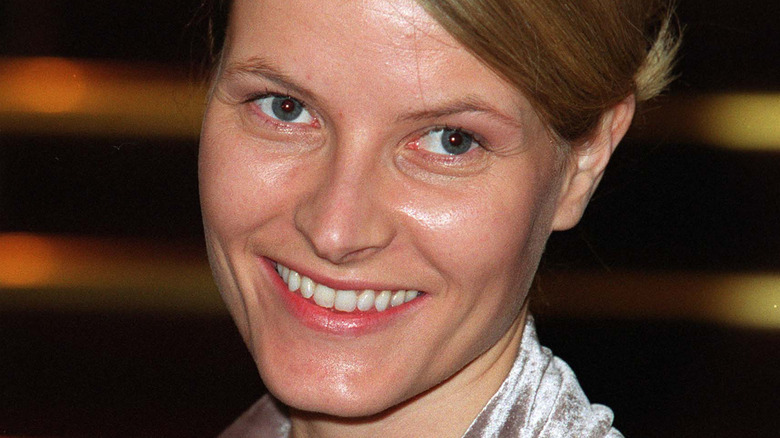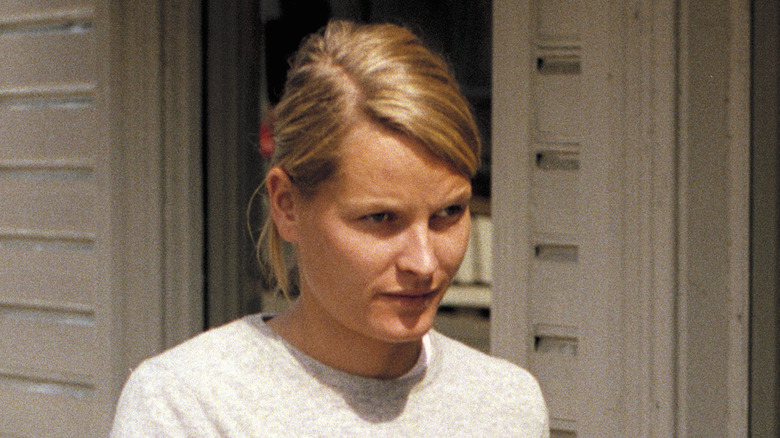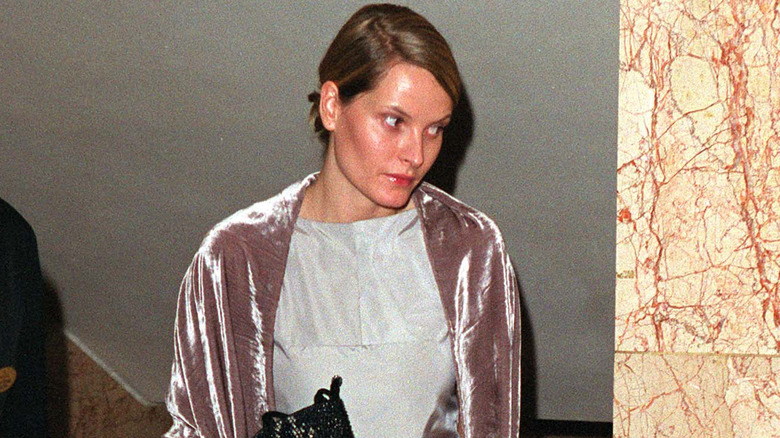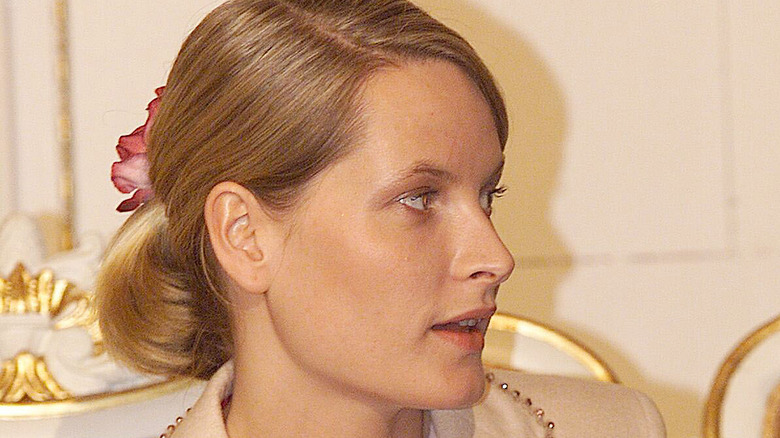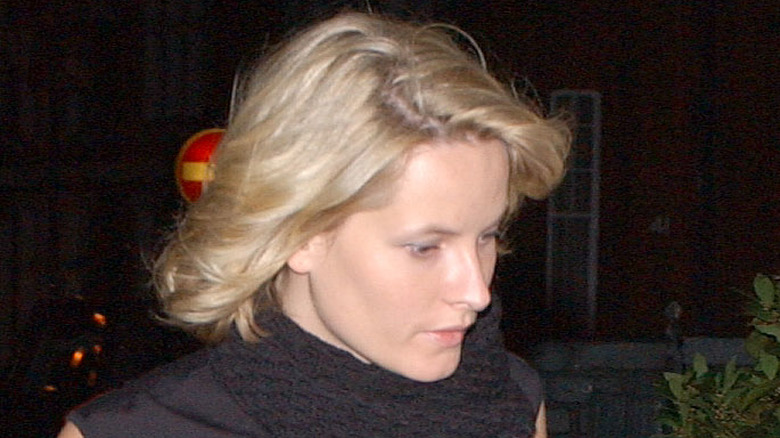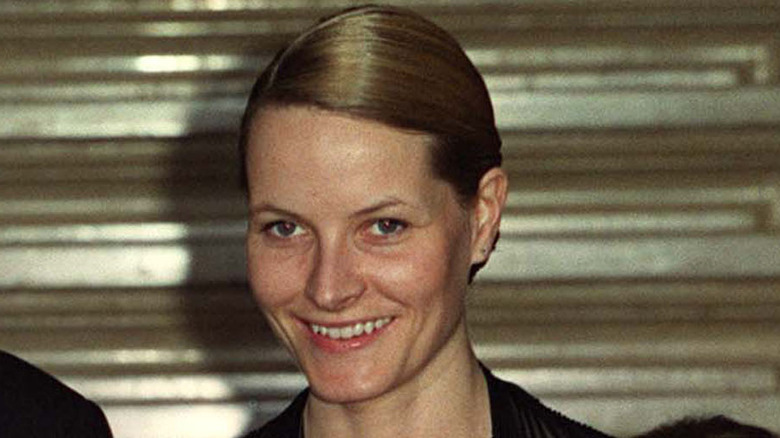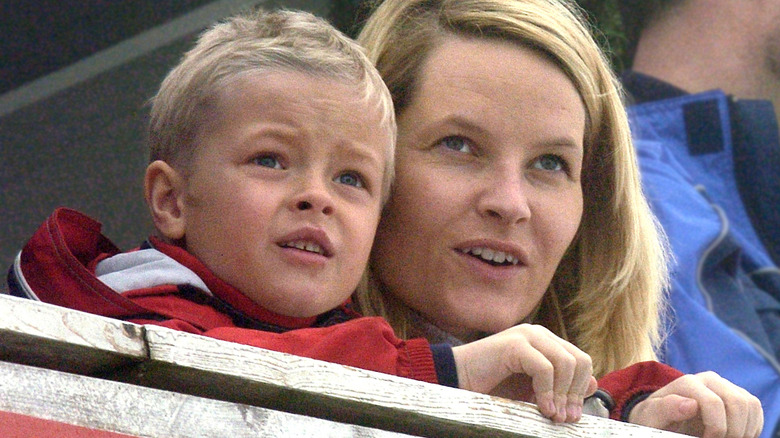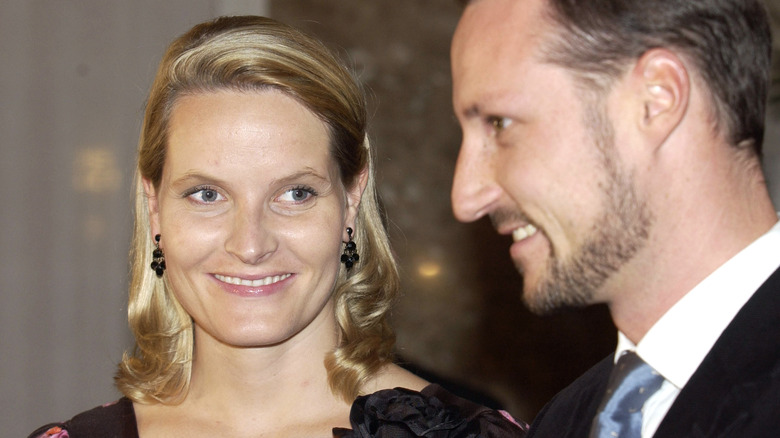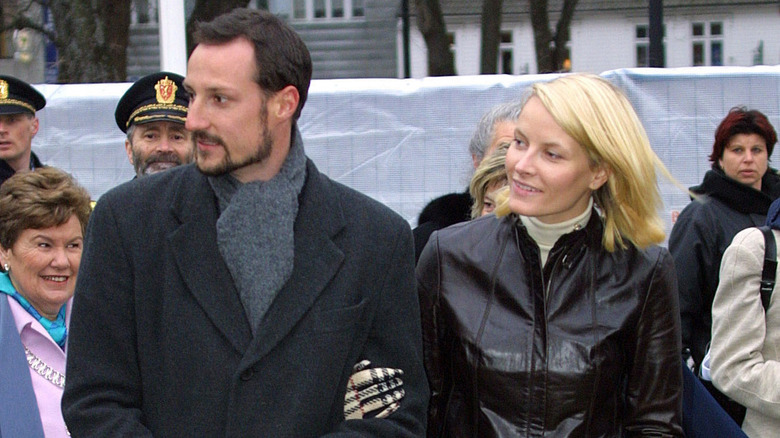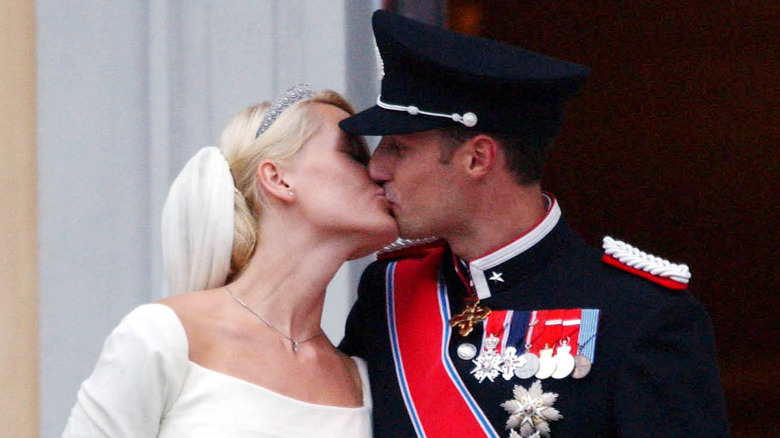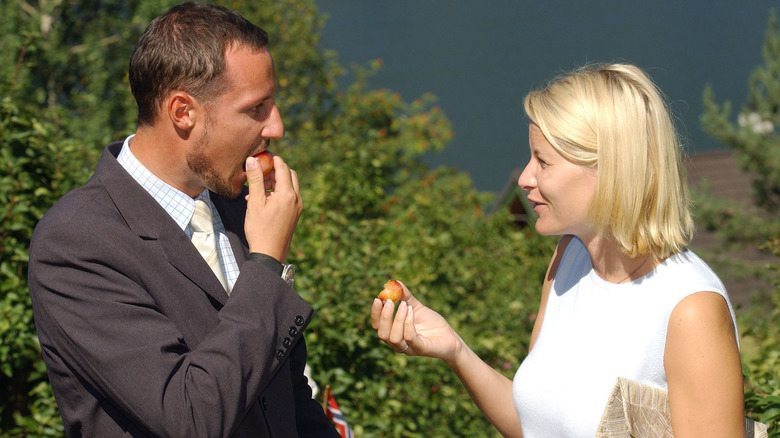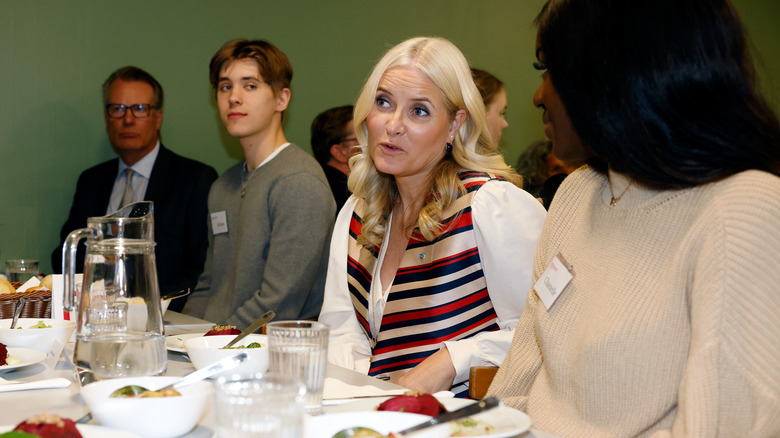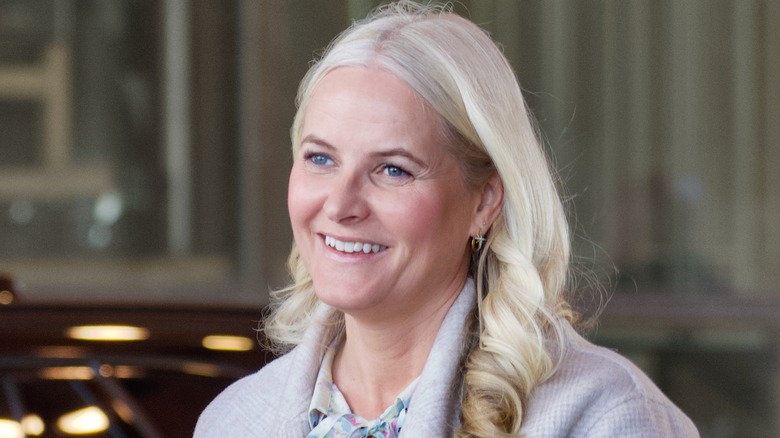The Gorgeous Evolution Of Norway's Crown Princess Mette-Marit
The following article includes references to alcoholism, drug misuse, and allegations of domestic abuse.
It's not exactly common for a commoner to marry into any European royal family. However, that's exactly what Princess Mette-Marit did when she tied the knot with Prince Haakon of Norway on August 25, 2001. Mette-Marit Tjessem Høiby, as she was once known, was born into a middle-class Norwegian family on August 19, 1973. To outsiders, her childhood appeared fairly normal. As Hello! magazine reported, she partook in sports, such as sailing and volleyball. However, her parents divorced in 1984 — and Mette-Marit didn't take it well, according to royal expert Peter Conradi's book, "Great Survivors."
Unlike some of the more proper members of European and British royalty, the Norwegian crown princess has a troubled past. A 2001 report published in the Los Angeles Times called the gorgeous blonde a "former wild child," referring to the years she spent in the drug-fueled techno music party scene. A report published in The Guardian the same year claimed the princess' ex was involved in dealing drugs.
Despite these scandals, Princess Mette-Marit became Norwegian royalty through marriage. And, as ABC News reported, the princess took on her royal duties to her subjects' satisfaction. However, the princess' major evolution did not go unnoticed by the public. Ever in awe of the ways Mette-Marit has changed over the years, the Norwegian people have nicknamed her Cinderella (via The Guardian).
Princess Mette-Marit's childhood was challenging
These days, Princess Mette-Marit travels all around the world, wearing ball gowns and a jeweled crown (via Vogue Scandinavia). However, the princess' childhood in the 1970s was hardly a fairytale. From the outside, Mette-Marit's family seemed like the typical middle-class Norwegian unit. Raised by a journalist father, Sven Høiby, and a bank employee mother, Marit Tjessem, Mette-Marit didn't lack food or clothing. Nonetheless, in her book "Homeland & Other Stories" (via Norwegian outlet VG), Mette-Marit revealed that her family was not as picture-perfect as it appeared. "I grew up in a poster family for success," she wrote. "All of us who lived in the house knew it wasn't true, but that's how we looked."
Despite her family's relative financial stability, Mette-Marit suffered greatly as a child. According to the princess' own account, one reason for her struggle was the pressure of keeping a major family secret: her father's misuse of alcohol. In a 2014 press conference in the town of Snåsa, Princess Mette-Marit opened up about this challenge. "As a child, I always felt that I had something I had to hide because none of my friends knew my father was an alcoholic," she shared (via The Local). Nowadays, however, Mette-Marit is at peace with her past. As she wrote in "Homeland & Other Stories" (via VG), "Today I can say that I am happy to have that experience with me."
If you or anyone you know is struggling with addiction issues, help is available. Visit the Substance Abuse and Mental Health Services Administration website or contact SAMHSA's National Helpline at 1-800-662-HELP (4357).
She tried to escape her unhealthy family dynamics
Because Princess Mette-Marit grew up in such difficult circumstances, she needed an outlet to get away from her family's unhealthy dynamics. During those grim younger years, one of Mette-Marit's primary escapes was reading. At a press conference in Snåsa, Norway, the princess discussed literature's ability to provide her with a safe space. "I think that the joy I had in being able to disappear into the world of books was strengthened by [my father's alcoholism]," she explained (via The Local). Additionally, in her book "Homeland & Other Stories" (via VG), Mette-Marit wrote, "It was a form of salvation for me, learning to read literature."
As the future princess got older, however, she began to look for different avenues of escape. By the time she started high school in the early 1990s, she was searching for ways to ditch her life in Norway. Ultimately, a foreign exchange program served the young blonde's purposes. Mette-Marit spent six months in the small Australian town of Wangaratta, according to Encyclopedia Britannica. Mette-Marit's Australian host father, Michael Green, claims that it was on this trip that the future princess began to experiment with alcohol. In the TV 2 documentary "The Cinderella of our Time," Green confessed to taking Mette-Marit to a bar. "She asked to have her first drink. I asked what she wanted, and she answered, '[a] cocktail,'" her former host father said (via Fædrelandsvennen).
Mette-Marit became an angry and rebellious teen
Unfortunately, Princess Mette-Marit's 1990 trip to Australia did little to heal the wounds of her childhood. On the contrary, she returned to her high school in Norway with more outward angst than ever before. The princess opened up about this phase of her life in the book "Homeland & Other Stories" (via VG), in which she wrote, "Until I went to Australia, I had been the most dutiful young person in the world. I was very kind, completely inside the box. Then, [I] just said stop, I couldn't do it anymore, in any case I couldn't live up to the expectations others had of me." For Mette-Marit, however, giving up on society's expectations involved a lot more than just a few failed tests. According to VG, the princess entered a much more self-destructive form of rebellion.
One of the most notable moments occurred during Mette-Marit's third year of high school. In the book "Great Survivors," journalist and royal expert Peter Conradi revealed that Mette-Marit shaved her head one day before class. According to Conradi, this hairstyle earned the approval of Mette-Marit's classmates, while it filled her mother with horror. As Mette-Marit wrote in "Homeland" (via VG), "I began to see that my childhood had done something to me, and I went through a phase where ... [my pain] came out in anger and sadness."
She began to date older guys
Following her return to Norway from Australia, the angsty student began dating a man two years her senior, according to royal expert Peter Conradi's book "Great Survivors." As detailed by Conradi, Mette-Marit's older boyfriend was part of the local party scene. He played in a band and often performed at parties that abounded in booze and hashish. Per "Great Survivors," Mette-Marit likely began to misuse marijuana during this relationship.
Following the future princess' high school graduation in 1994, she headed to the west Norwegian town of Lillestrøm. According to the documentary "The Cinderella of our Time" (via Fædrelandsvennen), this is where Mette-Marit developed feelings for another older man, John Ognby. However, the age difference this time was more than just a couple of years. Unlike Mettle-Marit's first boyfriend, Ognby was a whopping 15 years older than her (per "Great Survivors").
Apparently, the significant age gap didn't prevent Mettle-Marit from developing a serious relationship with Ognby. The couple got engaged, and Mette-Marit even purchased a wedding dress, per "The Cinderella of our Time" (via Fædrelandsvennen). However, by Conradi's account, the relationship quickly deteriorated into something dangerous. Mette-Marit eventually ended things with Ognby, who allegedly retaliated by threatening his former fiancée over the phone. The engagement ended definitively when Ognby was arrested for allegedly terrorizing Mette-Marit with a knife.
If you or someone you know is dealing with domestic abuse, you can call the National Domestic Violence Hotline at 1−800−799−7233. You can also find more information, resources, and support at their website.
Mette-Marit started to misuse drugs
One of the most troubling aspects of Princess Mette-Marit's past relationships with older men was the element of drug abuse. Her earliest boyfriends reportedly served as Mette-Marit's gateway to some element of the drug world. According to royal expert Peter Conradi's book "Great Survivors," John Ognby introduced her to an intense party scene following her 1994 high school graduation. This sub-culture was characterized by the frequent misuse of ecstasy and LSD.
As reported by the TV 2 documentary "The Cinderella of our Time" (via Fædrelandsvennen), Ognby took Mette-Marit to house parties, where he allegedly filmed her both using drugs and alcohol. Apparently, the resulting videotapes captured Mette-Marit in a particularly vulnerable moment. As Norwegian journalist Håvard Melnæs told the documentary makers, "The films are supposed to contain very strong scenes, both when it comes to drugs and sex."
Following the end of her engagement to John Ognby, Mette-Marit continued to frequent house parties. As her former friend Lars Eithun explained in the same documentary, "We danced, danced and, danced ... We crossed all the boundaries that [there] were. Ninety percent of those who attended the parties [were doing] drugs." By 1996, Mette-Marit became pregnant. According to The Observer, the baby's father, a friend of Ognby named Morten Borg, was convicted of cocaine possession just five years earlier.
The future princess became a single mother
On January 13, 1997, Princess Mette-Marit officially became a mother. According to a report by Hello! magazine, the Norwegian gave birth to a son, Marius Borg Høiby, in Oslo. Looking back at that moment, the princess recalled how her baby changed her life forever. In a 2017 open birthday letter to Marius published by the official Kongehuset, website, Princess Mette-Marit wrote, "Ever since I saw Marius open his eyes for the first time 20 years ago, I have been primarily a mother." Per the princess' account, she always took motherhood seriously, despite her other moments of youthful rebellion. "I was 23 years old and was given a great responsibility," she explained.
Because of her new role as Marius' mother, Mette-Marit decided to take a step back from the party world. As the documentary "The Cinderella of our Time" (via Fædrelandsvennen) revealed, the future princess tamed her wild side following the birth of her child. She stopped going out and started to focus on her son. As the princess wrote in her open letter to her son, "My obligation to [Marius] as a mother is to take seriously the responsibility that was given to me at Aker hospital 20 years ago." This sense of duty was perhaps particularly strong, as she did not remain with Marius' father (via International Business Times).
She met Prince Haakon through a mutual friend
A party girl and a crown prince may have seemed like an odd match. However, in the case of Princess Mette-Marit and Prince Haakon, it was a match made in heaven. The two crossed paths for the first time in 1996 when they were both attending a rock festival. According to Peter Conradi's book "Great Survivors," the unlikely pair was introduced by a festival organizer and mutual friend named Morten Andreassen. However, things didn't develop between the two until a bit later. Mette-Marit's father, Sven Høiby, told People that his daughter called him with the news of her relationship sometime in 1999. Per Høiby's account, Mette-Marit called him one night and said, "I've just been taken home in a taxi by the crown prince!"
As Mette-Marit's relationship with Prince Haakon evolved, the pair fell deeply in love. By September 2000, the couple announced their intention to move in together (via People). And, just two months later, they announced their engagement. Nonetheless, Mette-Marit was initially hesitant to accept Prince Haakon's proposal, due to his royal status, according to The Guardian. The outlet quoted Mette-Marit's explanation of her thought process: "It was not an easy choice. But I look forward to marrying Haakon and I look forward to entering that role. I just hope people will accept me for the person I am."
Mette-Marit convinced the Norwegian people to accept her relationship with the prince
While Prince Haakon had no trouble falling in love with his rebellious fiancée, the same could not be said for the public. Many Norwegians believed Mette-Marit's past made her unfit for a crown princess. As Nordic journalist Rune Saevik told People, "The establishment felt she was not good enough for the prince — too nontraditional, too middle-class — and there were questions about her past." British writer Jon Henley seemed to echo this sentiment in a 2000 piece for The Guardian, in which described Mette-Marit as Prince Haakon's "live-in girlfriend — a single mother whose former lover had multiple convictions for violence, drink-driving, and possession of cocaine."
Hoping to respond to the public's disapproval, Mette-Marit gave a press conference in 2001, just weeks before her wedding to Haakon. As reported by the BBC, the bride-to-be used her platform to address and atone for her past transgressions. "My youth rebellion was much stronger than many others," she confessed. The future princess went on to express regret over her past choices, saying, "I would like to take this opportunity to say that I condemn drugs. ... I cannot make these choices again, even though I would wish I could."
By most accounts, the press conference earned Mette-Marit a degree of public forgiveness. The day following the apology, Mette-Marit was spoken of positively in several newspapers (via NRK).
She married Prince Haakon in a romantic ceremony
Following the now-Princess Mette-Marit's 2001 apology, the public's hearts began to soften towards Prince Haakon's unconventional bride. As Norwegian reporter Rune Saevik told People, "Everyone expected there would be a scandal, but it never happened." Mette-Marit's former classmate Ann-Christine Pedersen Ronningen, who also spoke to the publication, didn't think much of the princess' youthful rebellion. "Did they expect the prince to find himself a 27-year-old virgin?" Ronningen asked rhetorically.
With relative public approval, Mette-Marit married Prince Haakon in a public ceremony on August 25, 2001, according to Tatler. The bride wore a gorgeous white crepe gown and an antique diamond tiara. The diadem, known as the Diamond Daisy Bandeau, was a gift to Mette-Marit from Prince Haakon's parents, King Harald V and Queen Sonja (via Daily Scandinavian).
Despite all the glam, Mette-Marit's wedding to Prince Haakon was an extremely emotional event. During the ceremony, Oslo Bishop Gunnar Stålsett gave a speech that moved Mette-Marit to tears, as reported by the Los Angeles Times. "You have not chosen the easiest path, but love has triumphed," Stålsett said.
Princess Mette-Marit had a smooth transition into royalty
It's no secret that marrying into a royal family can be challenging. Princess Diana, Sarah Ferguson, and Meghan Markle all famously struggled with their roles in the British monarchy. Luckily, however, Mette-Marit was able to make a much smoother transition into royal life, partially due to the more flexible nature of the Norwegian royal family. As royal expert Liv Berit Tessem revealed in a 2002 interview with ABC News, "The Norwegian royal family is much more relaxed than the English royal family was. I don't think you can compare the two families at all."
Despite rumored grumblings about Princess Mette-Marit's former commoner status, the newlywed princess was generally accepted by her people. In 2002, just one year after the Norwegian royal wedding, most of Mette-Marit's countrymen reported they were satisfied with her fulfillment of royal duties. Norwegian political scientist Håkon Kavli described the public's reaction towards the princess as positive when speaking with ABC News. "Since the marriage, she has completed all her official assignments to most Norwegians' liking," Kavli said. He added, "Only one out of 10 think she's a bad role model."
She became an activist princess
Part of Princess Mette-Marit's royal success probably pertains to her deep dedication to social issues. In 2006, she became a UNAIDS International Goodwill Ambassador, according to the organization. The princess' dedication to the AIDS response has spanned years. In a 2012 interview with CCTV, the princess expressed her vision for the future of AIDS research. "I think we have come very far ... but we also see the flattening out of international funding, and we can't let that happen."
Nevertheless, AIDS research is not the only social issue near and dear to Princess Mette-Marit. She also believes in the power of mothers to demystify issues of health and women's rights to their children. This is a particularly important issue to the princess, as she welcomed two additional children — Princess Ingrid Alexandra in 2004 and Prince Sverre Magno in 2005 (via Encyclopedia Britannica).
Of her experience as a mom, the princess told Hello! magazine, "I think as a mother whether you're talking about feminism or health, you need to be open. You have to give children the language to talk about the hard things in life and I think maybe that's the most important thing you can do as a mother."
She was diagnosed with a deadly disease
Despite Princess Mette-Marit's dedication to the Norwegian monarchy, her life as a royal has not been smooth sailing. In 2018, the princess announced that she'd been diagnosed with idiopathic pulmonary fibrosis, a rare degenerative lung disorder, as reported by the Daily Mail. According to the IPF Foundation, the disease has a 100% mortality rate for those who do not qualify for a lung transplant. As of this writing, there is no cure for IPF.
While news of this diagnosis was presumably difficult for the royal family, Princess Mette-Marit is dealing with her disease with a positive attitude. "For a number of years, I have had health challenges on a regular basis, and now we know more about what these are. Although such a diagnosis will limit my life at times, I'm glad that the disease has been discovered so early. My goal is still to work and participate in the official program as much as possible," she explained in a statement (via BBC News).
In late September 2022, the princess had to unexpectantly cancel royal engagements due to her health, and a statement from the royal family revealed she would be having surgery and taking a break from her royal duties until April 2023 (via Hello! magazine).
